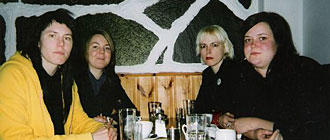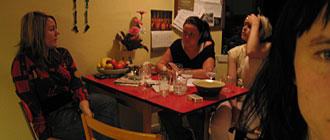Bakgrund / Background
Scroll down for english version.
- Om hur JA! bildades och varför.
Föreningen JA! har initierats av konstnärerna Line S Karlström, Johanna Gustafsson, Malin Arnell och Fia-Stina Sandlund.
I februari 2005 sammanfördes vi fyra av konstvetaren Eva Hallin, till ett samtal om ”feministiska motståndsstrategier” inför producerandet av utställningskatalogen som hör till utställningen Konstfeminism. Med det mötet som utgångspunkt och genom våra följande samtal började vi i grupp att reflektera över utställningens ramar.
Vi var eniga om att utställningen Konstfeminism (som då vi blev inbjudna hette Feministisk konst, helt enkelt) var ett viktigt och värdefullt men också mycket känsligt initiativ. Mycket stod på spel.
Vi var kritiska till många saker i utställningsarbetet. Inledningsvis var vi rädda för att den gömda agendan egentligen var att Liljevalchs konsthall och Dunkers Kulturhus behövde putsa upp sitt dåliga rykte i fråga om könsrepresentation i utställningsverksamheten och vid inköp. Att de deltagande konstnärerna knappt skulle få något betalt var inte heller ett gott tecken. Samtida konstnärer, av vilka många arbetar processinriktat och performativt visas på utställningen, med ett undantag, endast genom dokumentation – det finns alltså ingen budget för en samtida feministisk konstnärlig praktik.
Listan på deltagande konstnärer har från början inte heller innehållit utställare med annan etnisk bakgrund än ”svensk”. Utställningsgruppen talar om queer, men inte någonstans tar curatorerna hänsyn till det intersektionella perspektivet som enligt oss är det analytiska verktyg som bäst kan öka förståelsen av maktstrukturer och hierarkier.
Vi såg upplägget att klämma ihop ca 120 av Sveriges mest tongivande konstnärer, och kategorisera deras arbeten under olika teman som förminskande. Verk som haft en politisk sprängkraft riskerade att bli annekterade varumärken som skulle sprida sin glans över etablissemanget. Vi upplevde att utställningen Konstfeminism genom sitt fokus på 70-talet riskerade att bli en ofarlig utställning, en utställning som pekade bakåt. Vi delade en önskan om att vara de konstnärer som pekar framåt och vi ville att, dagens feministiska diskussion skulle finnas närvarande i utställningen. I ljuset av våra modiga, starka och fantastiska föregångare och med stöd av alla briljanta feministiska aktörer inom den samtida konsten bestämde vi att det var dags för Sveriges statliga konstinstitutioner att äntligen fixa det där med en verkligt jämställd och jämlik verksamhet.
Var institutionerna bakom utställningen Konstfeminism (och andra konstinstitutioner som i teorin säger sig vara för jämlikhet) beredda att praktisera? Var de redo för en juridisk överenskommelse – att ta ansvar för sin uttalade vilja till ökad jämlikhet – och skriva under ett bindande avtal?
That's the story. Och resten är historia som man brukar säga.

-------------
English version
- About how and why YES! was founded.
The YES! Association was initiated by the artists Line S Karlström, Johanna Gustafsson, Malin Arnell and Fia-Stina Sandlund.
The four of us were brought together in February 2005 by the art historian Eva Hallin, for a conversation about “feministic strategies of resistance”, in preparation for the production of the exhibition catalogue accompanying the exhibition Art Feminism. With this meeting as a starting point and through our following conversations we began, as a group, to reflect over the boundaries of the exhibition.
We agreed that the exhibition Art Feminism (that was simply called Feminist Art at the time when we were invited) was an important and valuable, but also very sensitive, initiative. A lot was at stake.
We were critical of much of the preparation work for the exhibition. Initially we were concerned that the hidden agenda was, in fact, that Liljevalchs Konsthall and Dunkers Kulturhus needed to improve their bad reputation in regards to gender representation in their exhibition programs and acquisitions. The participating artists would receive hardly any pay, which was not a good sign either. With only one exception, contemporary artists, many of whom work with process in focus and performative, are shown in the exhibition only through documentation – thus there is no budget for a contemporary feminist artistic practice.
Further, since the beginning, the list of participating artists has not included exhibitors of any other ethnic background than “Swedish”. The exhibition group talk about queer, but nowhere do the curators take any notice of the intersectional perspective which, according to us, is the analytic tool which best increase understanding of power structures and hierarchies.
We viewed the plan to squeeze together about 120 of Sweden’s most trendsetting artists, and categorising their work in different themes, as belittling. Works with a political force risked becoming annexed brands that would lend their brilliance to the establishment. We felt that the exhibition Art Feminism, through its focus on the 1970’s, risked turning out to be a safe exhibition; an exhibition pointing backwards. We shared a wish of being the artists who points forwards and we wanted to see the feministic discussion of today participating in the exhibition. In the light of our brave, strong and fantastic predecessors and with the support of all brilliant feminist actors within the contemporary art scene, we decided that it was time for all of Sweden’s public art institutions to finally sort out a truly equal and fair program.
Were the institutions behind the exhibition Art Feminism (and other art institutions that in theory claims to be all for equality) ready to practice what they preach? Were they ready for a legal agreement – to take responsibility for their expressed wish for raised equality – and sign a binding contract?
That is the story. And as the saying goes, the rest is history.



0 Comments:
<< Home